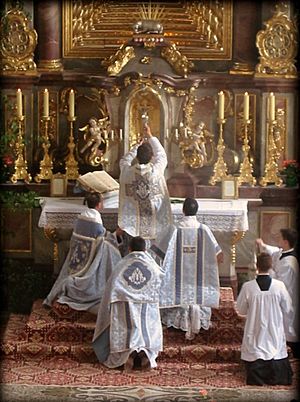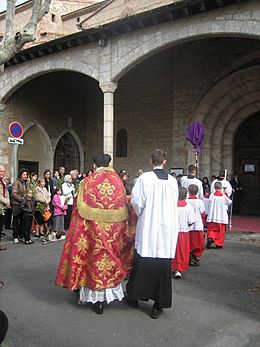Priestly Fraternity of Saint Peter facts for kids
|
Fraternitas Sacerdotalis Sancti Petri
|
|
 |
|
| Abbreviation | FSSP |
|---|---|
| Formation | July 18, 1988 |
| Founder | Josef Bisig |
| Type | Society of apostolic life of pontifical right (for men) |
| Headquarters | Maison Saint Pierre Canisius, Fribourg, Switzerland |
|
Membership (2022)
|
542 • 356 priests • 17 deacons • 169 seminarians |
|
Superior general
|
Andrzej Komorowski |
The Priestly Fraternity of Saint Peter (Latin: Fraternitas Sacerdotalis Sancti Petri; FSSP) is a group of traditionalist Catholic priests and students. They are fully part of the Catholic Church and follow the Pope.
This group was started in 1988 by 12 priests. These priests used to be part of another traditional Catholic group. However, they decided to leave after some bishops were made without the Pope's approval. This act led to those bishops being separated from the Church.
The FSSP has its main office in Switzerland. They also have two big schools, called seminaries, where young men study to become priests. One seminary is in Germany and the other is in the United States. The Catholic Church officially recognizes the FSSP. Its priests celebrate the older form of the Mass, known as the Tridentine Mass, in many places around the world.
Contents
What is the FSSP?
According to the rules of the Catholic Church, the FSSP is a special type of organization for priests. It is called a "clerical society of apostolic life of pontifical right." This means it was set up by the Pope himself. Because of this, the FSSP answers directly to the Pope about how it operates. It does not answer only to local bishops.
Members of the FSSP do not take special religious vows like monks or nuns. Instead, they follow the same rules as other priests. They promise to live a celibate life and obey their leaders. A local bishop still guides the FSSP's work in his own area.
What the FSSP Does
The FSSP is made up of priests and students who want to live a holy life. They do this by offering the Mass and other sacraments in a specific way. They use the older form of the Roman Rite, which was used before the changes made after the Second Vatican Council.
This means the FSSP uses the prayer books and rituals that were common in 1962. These are the last versions before the Church made some updates.
In 2007, Pope Benedict XVI allowed all Catholic priests to use the 1962 Roman Missal. This was called the "extraordinary form" of the Mass. However, in 2021, Pope Francis added some new rules. These rules made the newer form of the Mass the main one. They also added more limits on who could use the older form.
But in February 2022, Pope Francis confirmed that the FSSP could keep celebrating the Latin Mass. They can do this in their own churches or chapels.
The FSSP has two main goals. First, they want to help each priest become more holy through his work. Second, they send these priests to different parishes. There, the priests celebrate the sacraments and teach about the Catholic faith. They also lead retreats and pilgrimages. Their aim is to provide a full spiritual life for Catholics who prefer the older rituals. To help with this, the FSSP has built its own schools to train new priests.
How the FSSP Started
For the honour and glory of the holy Catholic Church, for the consolation of the much troubled faithful, and for the peace of their conscience, the undersigned, members until now of the Fraternity of Saint Pius X, declare with profound regret over the illicit consecration of bishops on 30 June [1988] that they have remained within the Catholic Church as pars sanior of this same Fraternity, and that they have but one desire: to be able to live as a religious society in this Church and place themselves at her service under the authority, of course, of the Roman Pontiff, her supreme head.
—From the Declaration of Intention by the Founders (2 July 1988)
The FSSP was founded on July 18, 1988, in Hauterive, Switzerland. It was started by twelve priests and twenty students. They were led by Josef Bisig. All of them had previously been part of Archbishop Marcel Lefebvre's Society of Saint Pius X.
They chose not to follow that group when four bishops were made without the Pope's permission. The Catholic Church said this was an act that separated them from the Church. Josef Bisig became the first leader of the FSSP.
Organization of the FSSP
As of November 2021, the FSSP had 526 members. This included 341 priests, 17 deacons, and 168 students. They serve in 147 different areas around the world. These areas include countries like Australia, Canada, France, Germany, the United States, and Vietnam.
The members of the FSSP come from 35 different countries. Their average age is 38. Also, a group of Catholic people, called the lay Confraternity of Saint Peter, has 8,399 members. These members support the FSSP's mission through prayer.
Leaders of the FSSP
The current leader of the FSSP is Andrzej Komorowski. He was chosen in 2018. Past leaders include:
- Josef Bisig (1988–2000)
- Arnaud Devillers (2000–2006)
- John Berg (2006–2018)
Regions and Schools
The FSSP divides its work into four main areas:
- German-speaking District, led by Stefan Dreher
- French District, led by Benoît Paul-Joseph
- North American Province, led by William Lawrence
- Oceania District, led by Michael McCaffrey
The FSSP has two main schools for training priests:
- The International Seminary of St. Peter is in Wigratzbad-Opfenbach, Germany. It opened in 1988. This school is for students who speak French and German.
- Our Lady of Guadalupe Seminary is in Denton, Nebraska, United States. It opened in 1994. This school is for students who speak English.
There is also Ezekiel House in Sydney, Australia. This is a special house for first-year students. In 2015, the FSSP started Casa Cristo Rey in Guadalajara, Mexico. This place helps young men from Spain and Latin America think about becoming priests. It also offers a program to learn Spanish.
See also
 In Spanish: Fraternidad Sacerdotal de San Pedro para niños
In Spanish: Fraternidad Sacerdotal de San Pedro para niños
- George Gabet
- Antony Sumich



